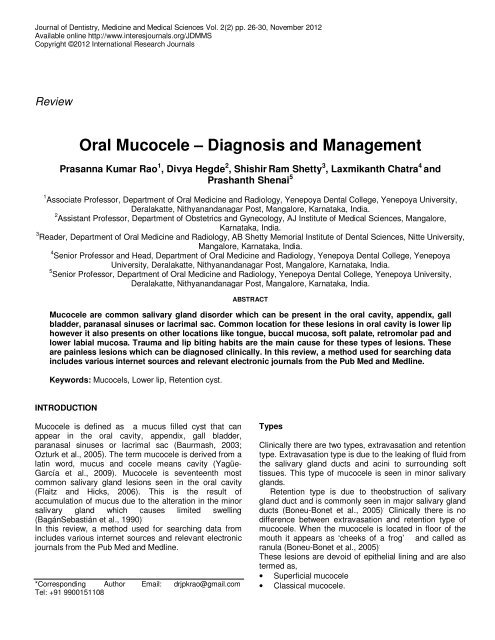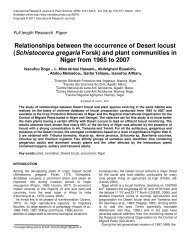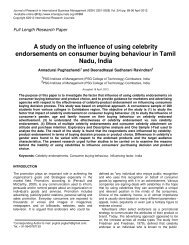Oral Mucocele - International Research Journals
Oral Mucocele - International Research Journals
Oral Mucocele - International Research Journals
Create successful ePaper yourself
Turn your PDF publications into a flip-book with our unique Google optimized e-Paper software.
Journal of Dentistry, Medicine and Medical Sciences Vol. 2(2) pp. 26-30, November 2012<br />
Available online http://www.interesjournals.org/JDMMS<br />
Copyright ©2012 <strong>International</strong> <strong>Research</strong> <strong>Journals</strong><br />
Review<br />
<strong>Oral</strong> <strong>Mucocele</strong> – Diagnosis and Management<br />
Prasanna Kumar Rao 1 , Divya Hegde 2 , Shishir Ram Shetty 3 , Laxmikanth Chatra 4 and<br />
Prashanth Shenai 5<br />
1 Associate Professor, Department of <strong>Oral</strong> Medicine and Radiology, Yenepoya Dental College, Yenepoya University,<br />
Deralakatte, Nithyanandanagar Post, Mangalore, Karnataka, India.<br />
2 Assistant Professor, Department of Obstetrics and Gynecology, AJ Institute of Medical Sciences, Mangalore,<br />
Karnataka, India.<br />
3 Reader, Department of <strong>Oral</strong> Medicine and Radiology, AB Shetty Memorial Institute of Dental Sciences, Nitte University,<br />
Mangalore, Karnataka, India.<br />
4 Senior Professor and Head, Department of <strong>Oral</strong> Medicine and Radiology, Yenepoya Dental College, Yenepoya<br />
University, Deralakatte, Nithyanandanagar Post, Mangalore, Karnataka, India.<br />
5 Senior Professor, Department of <strong>Oral</strong> Medicine and Radiology, Yenepoya Dental College, Yenepoya University,<br />
Deralakatte, Nithyanandanagar Post, Mangalore, Karnataka, India.<br />
ABSTRACT<br />
<strong>Mucocele</strong> are common salivary gland disorder which can be present in the oral cavity, appendix, gall<br />
bladder, paranasal sinuses or lacrimal sac. Common location for these lesions in oral cavity is lower lip<br />
however it also presents on other locations like tongue, buccal mucosa, soft palate, retromolar pad and<br />
lower labial mucosa. Trauma and lip biting habits are the main cause for these types of lesions. These<br />
are painless lesions which can be diagnosed clinically. In this review, a method used for searching data<br />
includes various internet sources and relevant electronic journals from the Pub Med and Medline.<br />
Keywords: Mucocels, Lower lip, Retention cyst.<br />
INTRODUCTION<br />
<strong>Mucocele</strong> is defined as a mucus filled cyst that can<br />
appear in the oral cavity, appendix, gall bladder,<br />
paranasal sinuses or lacrimal sac (Baurmash, 2003;<br />
Ozturk et al., 2005). The term mucocele is derived from a<br />
latin word, mucus and cocele means cavity (Yagüe-<br />
García et al., 2009). <strong>Mucocele</strong> is seventeenth most<br />
common salivary gland lesions seen in the oral cavity<br />
(Flaitz and Hicks, 2006). This is the result of<br />
accumulation of mucus due to the alteration in the minor<br />
salivary gland which causes limited swelling<br />
(BagánSebastián et al., 1990) .<br />
In this review, a method used for searching data from<br />
includes various internet sources and relevant electronic<br />
journals from the Pub Med and Medline.<br />
*Corresponding Author Email: drjpkrao@gmail.com<br />
Tel: +91 9900151108<br />
Types<br />
Clinically there are two types, extravasation and retention<br />
type. Extravasation type is due to the leaking of fluid from<br />
the salivary gland ducts and acini to surrounding soft<br />
tissues. This type of mucocele is seen in minor salivary<br />
glands.<br />
Retention type is due to theobstruction of salivary<br />
gland duct and is commonly seen in major salivary gland<br />
ducts (Boneu-Bonet et al., 2005) . Clinically there is no<br />
difference between extravasation and retention type of<br />
mucocele. When the mucocele is located in floor of the<br />
mouth it appears as ‘cheeks of a frog’ and called as<br />
ranula (Boneu-Bonet et al., 2005) .<br />
These lesions are devoid of epithelial lining and are also<br />
termed as,<br />
• Superficial mucocele<br />
• Classical mucocele.
Figure 1. Provide legend<br />
Superficial mucocele are located under the mucous<br />
membrane and classical mucocele are seen in the upper<br />
submucosa (Baurmash, 2003: Selim and Shea, 2007).<br />
Etiopathogenesis<br />
The two important etiological factors are (Yamasoba et<br />
al., 1990)<br />
I. Trauma and<br />
II. Obstruction of salivary gland duct.<br />
Mainly physical trauma causes a spillage of salivary<br />
secretion into surrounding submucosal tissue. Later<br />
inflammation may become obvious due to stagnant<br />
mucous (Boneu-Bonet et al., 2005). Habit of lip biting and<br />
tongue thrusting are also one of the aggravating factors<br />
(Gupta et al., 2007).<br />
The extravasation type will undergo three evolutionary<br />
phases (Ata-Ali et al., 2010).<br />
I. In the first phase there will be spillage of mucus from<br />
salivary duct into the surrounding tissue in which<br />
some leucocytes and histiocytes are seen.<br />
II. In second phase, granulomas will appear due to the<br />
presence of histiocytes, macrophages and giant<br />
multinucleated cells associated with foreign body<br />
reaction. This second phase is called as resorption<br />
phase.<br />
III. Later in third phase there will be a formation of<br />
pseudocapsule without epithelium around the mucosa<br />
due to connective cells.<br />
The retention type of mucocele is commonly seen in<br />
major salivary glands. It is due to the dilatation of duct<br />
due to block caused by a sialolith or dense mucosa (Ata-<br />
Ali et al., 2010). It depends upon the obstruction of<br />
salivary flow from secretory apparatus of the gland (Flaitz<br />
and Hicks, 2006).<br />
Clinical characteristics<br />
<strong>Mucocele</strong> is the common salivary gland disorder and it is<br />
the second t common benign soft tissue tumor in the oral<br />
Rao et al. 27<br />
cavity (Baurmash, 2002). It is characterised by<br />
accumulation of mucoid material with rounded, well<br />
circumscribed transparent, bluish coloured lesion of<br />
variable size. It is a soft and fluctuant asymptomatic<br />
swelling with rapid onset which frequently resolves<br />
spontaneously (Eveson, 1988; Bermejo et al., 1999).<br />
Common in the lower lip but may occur in other locations<br />
also. [ 14] .The bluish discoularation is mainly due to the<br />
vascular congestion and cyanosis of the tissue above<br />
and the fluid accumulation below.<br />
It also depends on the size of the lesion, proximity to<br />
the surface and upper tissue elasticity (Baurmash, 2003;<br />
Bentley et al., 2003).<br />
Size may be few millimeters to centimeters and occurs<br />
singly and rarely bilateral (Flaitz and Hicks, 2006; López-<br />
Jornet, 2006). They are usually doom shaped swellings<br />
with intact epithelium over it (Figure 2, 3, 4). Sometimes<br />
superficial mucocele with single or multiple blisters seen<br />
on the soft palate, retromolar pad, posterior buccal<br />
mucosa and lower labial mucosa rupture spontaneously.<br />
and become ulcerated mucosal surface and heals within<br />
few days (Gupta et al., 2007).<br />
It seen equally in men and women. It is common in<br />
first three decade of life (Selim and Shea, 2007) . The<br />
differential diagnosis which can be considered are<br />
Blandin and Nuhnmucocele, Benign or malignant salivary<br />
gland neoplasms, oral hemangioma, oral<br />
lymphangioma,Venous varix or venous lake,lipoma,soft<br />
irritation fibroma, oral lymphoepithelial cyst, gingival cyst<br />
in adults, soft tissue abscess,cysticercosis. Superficial<br />
mucocele may be confused with cicatricial<br />
pemphigoid,bullous lichen planus and minor aphthous<br />
ulcers (Gupta et al., 2007).<br />
Diagnosis<br />
The appearance of mucocele is pathognomonic so the<br />
data about the lesion location, history of trauma, rapid<br />
appearance, variations in size, bluish colour and the<br />
consistency helps in diagnosis of such lesions (Bentley et<br />
al., 2003; Andiran et al., 2001; Guimarães et al., 2006).
28 J. Dent. Med. Med. Sci.<br />
Figure 2. Mucolele on the right side of the lower lip<br />
Figure 3. Mucolele on the left side of the buccal mucosa<br />
Figure 4. <strong>Mucocele</strong> on theleft side buccal sulcus
Usually this lesion has a soft and elastic consistency<br />
which depends on tissue present over the lesion<br />
(Bentley et al., 2003) . History and clinical findings will<br />
lead to the diagnosis in case of superficial mucocele.<br />
Fine needle aspiration demonstrates the mucus retention,<br />
histiocytes and inflammatory cells (Layfield and Gopez,<br />
2002). In retention type mucoceles, cystic cavity with<br />
well-defined epithelial wall lined with cuboidal cells are<br />
present. This type shows less inflammatory reaction<br />
(Guimarães et al., 2006). The extravasation type is a<br />
pseudocyst without epithelial wall and shows<br />
inflammatory cells and granulation tissues (Guimarães et<br />
al., 2006). Chemical analysis of saliva shows high<br />
amylase and protein content.<br />
Radiographs are the contributing factors in diagnosis<br />
of ranulas. Localization of these lesions is done by<br />
computed Tomography and Magnetic Resonance<br />
Imaging (Gupta et al., 2007). Histopathologically it shows<br />
ductal epithelium, granulation tissue, pooling of mucin<br />
and inflammatory cells (Figure 5)<br />
Treatment<br />
Conventional surgical removal is the most common<br />
method used to treat this lesion. Other treatment options<br />
include CO2laser ablation, cryosurgery, intralesional<br />
corticosteroid injection, micro marsupialization,<br />
marsupialization and electrocautery (López-Jornet and<br />
Bermejo-Fenoll, 2004; Ishida and Ramos-e-Silva, 1998;<br />
Kopp and St-Hilaire, 2004; García et al., 2009). Some<br />
studies suggested that the initial cryosurgical approach or<br />
intralesional corticosteroid injection in the treatment of<br />
these lesions but cases of relapses in these techniques is<br />
more (García et al., 2009). There is no difference in the<br />
Figure 4. Photomicrograph showing ductal epithelium and<br />
inflammatory cells<br />
Rao et al. 29<br />
treatment of retention and extravasation mucocele. Small<br />
sized mucoceles are removed with marginal glandular<br />
tissue and in case of large lesions marsupialization will<br />
help to avoid damage to vital structures and decrease the<br />
risk of damaging the labial branch of mental nerve<br />
(García et al., 2009). Lacrimal catheters are used to<br />
dilate the duct to remove the obstruction of retention type<br />
mucoceles (Baurmash, 2003; Gupta et al., 2007). While<br />
removing the mucocele surgically, remove the<br />
surrounding glandular acini.removing the lesion down to<br />
the muscle layer and avoiding the adjacent gland and<br />
duct damage while placing the suture will reduces the<br />
chances of recurrence (Baurmash, 2003; Huang et al.,<br />
2007). Removal of surrounding glandular acini, excision<br />
or dissection of lesion down to the muscle layer and<br />
avoiding damage to adjacent gland and duct are some<br />
strategies to reduce recurrence. If the fibrous wall of the<br />
mucocele is thick, then the removed tissue must be sent<br />
for histopathological examination to rule out any salivary<br />
gland neoplasms (Gupta et al., 2007).<br />
The micromarsupialization is considered as an ideal<br />
treatment in case of pediatric patient because this<br />
technique is simple, rapid and less chances of recurrence<br />
(Delbem et al., 2000).<br />
The advantage in CO2 laser is it minimizes the<br />
recurrences and complications and allows rapid, simple<br />
mucocele ablation. It is also indicated for the patients<br />
who cannot tolerate long procedures (García et al.,<br />
2009).<br />
CONCLUSION<br />
<strong>Mucocele</strong> is the most common benign self-limiting<br />
condition. It is commonly seen in young males. Trauma is
30 J. Dent. Med. Med. Sci.<br />
the most common cause and majority of these lesions<br />
are seen in lower lips. Majority of these cases can be<br />
diagnosed clinically however sometimes biopsy is<br />
required to rule out any other types of neoplasm. There<br />
are various treatment options available but the CO2 laser<br />
treatment shows more benefits and less relapses. There<br />
are various treatment options available but the CO2 laser<br />
treatment is a better option with the least chances of<br />
recurrence. Since these lesions are painless, it is the<br />
dentists, who usually pick up these lesions when the<br />
patient comes for a routine oral check or an unrelated<br />
dental problem,<br />
REFERENCES<br />
Andiran N, Sarikayalar F, Unal OF, Baydar DE, Ozaydin E (2001).<br />
<strong>Mucocele</strong> of the anterior lingual salivary glands: from extravasation<br />
to an alarming mass with a benign course. Int J Pediatr<br />
Otorhinolaryngol. 61:143-47.<br />
Ata-Ali J, Carrillo C ,Bonet C , Balaguer J, Peñarrocha M , Peñarrocha<br />
M (2010). <strong>Oral</strong> mucocele: review of the literature. J ClinExp Dent.<br />
2:e18-21.<br />
BagánSebastián JV, Silvestre Donat FJ, PeñarrochaDiago M,<br />
MiliánMasanet MA (1990). Clinico-pathological study of oral<br />
mucoceles. Av Odontoestomatol. 6:389-91, 394-95.<br />
Baurmash H (2002). The etiology of superficial oral mucoceles. J <strong>Oral</strong><br />
Maxillofac Surg. 60:237-8.<br />
Baurmash HD (2003). <strong>Mucocele</strong>s and ranulas. J <strong>Oral</strong> Maxillofac Surg.<br />
61:369-78.<br />
Bentley JM, Barankin B, Guenther LC (2003). A review of common<br />
pediatric lip lesions: herpes simplex/recurrent herpes labialis,<br />
impetigo,mucoceles, and hemangiomas. ClinPediatr (Phila). 42:475-<br />
82.<br />
Bermejo A, Aguirre JM, López P, Saez MR (1999). Superficial<br />
mucocele:report of 4 cases. <strong>Oral</strong> Surg <strong>Oral</strong> Med <strong>Oral</strong> Pathol <strong>Oral</strong><br />
Radiol Endod. 88:469-72.<br />
Boneu-Bonet F, Vidal-Homs E, Maizcurrana-Tornil A, González-<br />
Lagunas J (2005). Submaxillary gland mucocele: presentation of a<br />
case. Med <strong>Oral</strong> Patol <strong>Oral</strong> Cir Bucal. 10:180-84.<br />
Delbem AC, Cunha RF, Vieira AE, Ribeiro LL (2000).“ Treatment of<br />
mucus retention phenomena in children by the micromarsupialization<br />
technique: case reports. Pediatr Dent. 22:155-58.<br />
Eveson JW (1988). Superficial mucoceles: pitfall in clinical and<br />
microscopic diagnosis. <strong>Oral</strong> Surg <strong>Oral</strong> Med <strong>Oral</strong> Pathol. 66:318-22.<br />
Flaitz CM, Hicks JM (2006). <strong>Mucocele</strong> and ranula.eMedicine. Retrieved<br />
19 October from http://www.emedicine.com/derm/topic648.htm<br />
García JY, Tost AJE, Aytés LB, Escoda CG (2009). Treatment of oral<br />
mucocele - scalpel versus C02 laser. Med <strong>Oral</strong> Patol <strong>Oral</strong> Cir Bucal.<br />
14 :e469-74.<br />
Guimarães MS, Hebling J, Filho VA, Santos LL, Vita TM, Costa CA<br />
(2006). Extravasationmucocele involving the ventral surface of the<br />
tongue (glands of Blandin-Nuhn). Int J Paediatr Dent. 16:435-39.<br />
Gupta B, Anegundi R, SudhaP,Gupta M (2007). <strong>Mucocele</strong>:Two Case<br />
Reports. J <strong>Oral</strong> Health Comm Dent 1:56-58<br />
Huang IY, Chen CM, Kao YH, Worthington P (2007). Treatment of<br />
mucocele of the lower lip with carbon dioxide laser. J <strong>Oral</strong> Maxillofac<br />
Surg. 65:855-58.<br />
Ishida CE and Ramos-e-Silva M (1998). Cryosurgery in oral lesions. Int<br />
J Dermatol, 37: 283-85.<br />
Kopp WK, St-Hilaire H (2004). Mucosal preservation in the treatment of<br />
mucocele with CO2 laser. J <strong>Oral</strong> Maxillofac Surg. 62: 1559-61.<br />
Layfield LJ, Gopez EV (2002). Cystic lesions of the salivary glands:<br />
cytologic features in fine-needle aspiration biopsies.<br />
DiagnCytopathol. 27:197-204.<br />
López-Jornet P (2006). Labial mucocele: a study ofeighteen cases. The<br />
Internet Journal of Dental Science, 3(2). Retrieved 7 February 2007,<br />
from http://www.ispub.com/ostia/index.php?xmlFilePath=journals/<br />
ijds/vol3n2/labial.xml.<br />
López-Jornet P, Bermejo-Fenoll A (2004). Point of Care: What is the<br />
most appropriate treatment for salivary mucoceles? Which is the<br />
best technique for this treatment? J Can Dent Assoc, 70: 484-85.<br />
Ozturk K, Yaman H, Arbag H, Koroglu D, Toy H (2005). Submandibular<br />
gland mucocele: report of two cases. <strong>Oral</strong> Surg <strong>Oral</strong> Med <strong>Oral</strong><br />
Pathol <strong>Oral</strong> RadiolEndod. 100:732-35.<br />
Seifert G, Miehlke A, Haubrich J, Chilla R (1986). Diseases of the<br />
salivary glands. Stuttgart: GeorgThieme Verlag. pp. 91-100.<br />
Selim MA, Shea CR (2007). Mucous cyst.eMedicine. Retrieved 7<br />
February from:http://www.emedicine.com/derm/topic274.htm.<br />
Yagüe-García J, España-Tost AJ, Berini-Aytés L, Gay-Escoda C<br />
(2009). Treatment of oral mucocele - scalpel versus C02 laser. Med<br />
<strong>Oral</strong> Patol <strong>Oral</strong> Cir Bucal. 14 :e469-74.<br />
Yamasoba T, Tayama N, Syoji M, Fukuta M (1990). Clinicostatistical<br />
study of lower lip mucoceles. Head Neck. 12:316-20.














